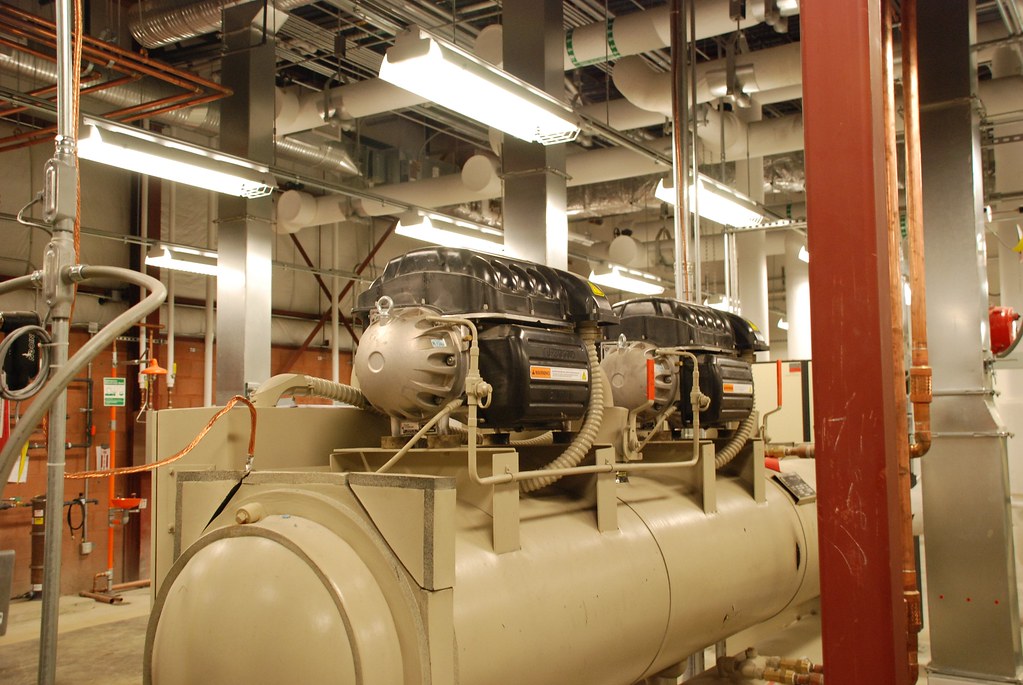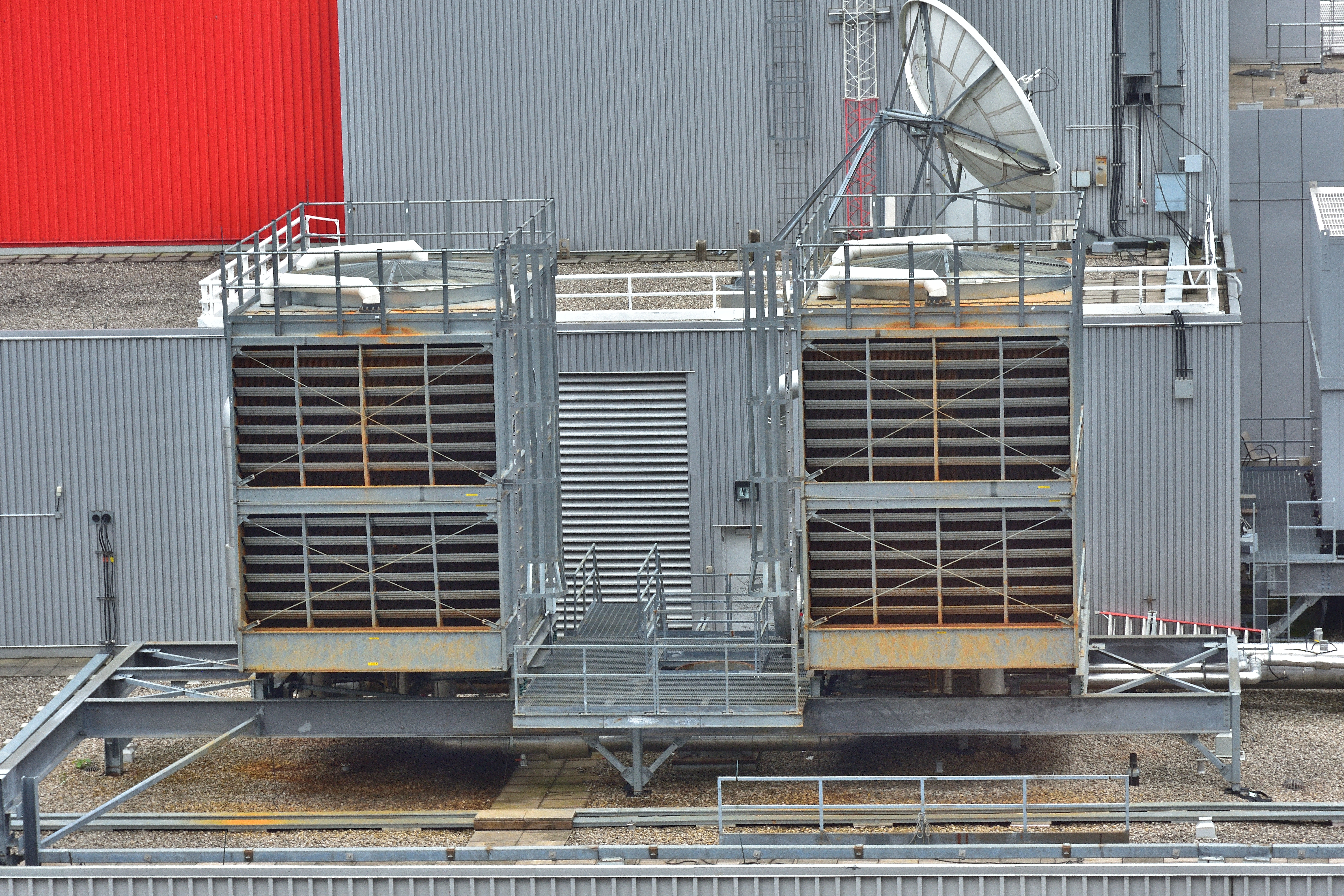Introduction
Cooling systems are essential in industrial facilities to regulate temperature, ensure equipment longevity, and maintain product quality. Two primary cooling technologies used in industrial settings are chillers and cooling towers. This module explores their operation, energy efficiency considerations, and best practices for optimization.
Chillers

Chillers are refrigeration systems that remove heat from a process fluid or space. They operate using either a vapor compression cycle or an absorption refrigeration cycle.
Types of Chillers
- Air-Cooled Chillers
- Use ambient air to remove heat from the refrigerant
- Suitable for facilities with limited water availability
- Higher energy consumption compared to water-cooled chillers
- Water-Cooled Chillers
- Use water from a cooling tower to dissipate heat
- More efficient in large-scale applications
- Require additional maintenance due to water treatment needs
- Absorption Chillers
- Use heat instead of electricity to drive the cooling cycle
- Often powered by waste heat or steam from industrial processes
- Lower electrical consumption but higher capital costs
Chiller Efficiency Metrics
- Coefficient of Performance (COP): Ratio of cooling output to energy input
- Integrated Part Load Value (IPLV): Measures efficiency under varying load conditions
- Kilowatts per Ton (kW/ton): Power required to produce one ton of cooling
Optimization Strategies
- Proper sizing: Avoid oversizing, which leads to inefficiencies
- Variable speed drives (VSDs): Adjust compressor speed based on cooling demand
- Regular maintenance: Clean heat exchangers, check refrigerant levels, and inspect insulation
- Load shifting: Use thermal energy storage to shift cooling loads to off-peak hours
More Resources
Check out this video by Mike Muller going in-depth about chillers:
Check out this video about how chillers operate:
Cooling Towers

Cooling towers remove heat from water-cooled systems by evaporating water into the atmosphere. They are widely used in conjunction with water-cooled chillers to enhance efficiency.
Check out this video discussing how they work on a high-level:
Types of Cooling Towers
- Open-Circuit (Wet) Cooling Towers
- Water directly contacts air, allowing heat dissipation through evaporation
- Highly efficient but requires water treatment to prevent scaling and biological growth
- Closed-Circuit (Dry) Cooling Towers
- Use a heat exchanger to separate process water from cooling air
- Lower water consumption but less efficient than open-circuit towers
Key Performance Indicators
- Approach Temperature: Difference between cooled water temperature and ambient wet-bulb temperature
- Cycles of Concentration (COC): Ratio of dissolved solids in recirculating water to makeup water
- Drift Loss: Water loss due to fine droplets escaping with exhaust air
Optimization Strategies
- Install variable frequency drives (VFDs): Adjust fan speeds based on load
- Monitor water chemistry: Prevent scaling and biological contamination
More Resources
Check out this video by Mike Muller discussing cooling towers:
Activity
Objective:
Calculate the energy and demand savings associated with upgrading an older chiller system to a more efficient model using provided efficiency, runtime, and capacity data.
Problem Statement:
A manufacturing plant operates a set of four Carrier chillers, three of which were installed in 1995 and have degraded efficiency. The original efficiency of these older chillers was 0.67 kW/ton, but due to degradation over 29 years, the efficiency has worsened to 0.90 kW/ton. The plant is considering replacing these with modern chillers with an efficiency of 0.60 kW/ton.
Using the following provided data, calculate the annual energy savings (kWh) from upgrading the older chillers.
Given Data: - Chiller capacity = 1,250 tons - Efficiency of degraded chillers = 0.90 kW/ton - Efficiency of new chillers = 0.60 kW/ton - Annual runtime of older chillers = 8,760 hours × 54.57% = 4,780.33 hours - Degradation factor formula:
\[\text{Efficiency}{\text{Degraded}} = \frac{\text{Efficiency}{\text{Original}}}{(1 - 0.01)^{\text{Age}}}\]
Tasks:
-
Recalculate the degraded efficiency of the older chillers using the formula above, assuming an original efficiency of 0.67 kW/ton and an age of 29 years.
-
Calculate the annual energy savings in kWh using the formula:
\[\text{Consumption Savings} = \text{Capacity} \times (\text{Efficiency}{\text{Degraded}} - \text{Efficiency}{\text{New}}) \times \text{Annual Runtime}\]
Quiz
1. What is the primary function of a cooling tower in an HVAC or industrial system?
a) Increase air temperature
b) Remove heat from a process by evaporative cooling
c) Generate electricity
d) Convert water into steam
2. Which factor has the greatest impact on the efficiency of a cooling tower?
a) The material of the fill media
b) The relative humidity of the surrounding air
c) The speed of the circulation pump
d) The size of the fan motor
3. What is the main difference between an air-cooled chiller and a water-cooled chiller?
a) Air-cooled chillers use fans to dissipate heat, while water-cooled chillers use cooling towers
b) Air-cooled chillers require less maintenance than water-cooled chillers
c) Water-cooled chillers are only used in industrial applications
d) Air-cooled chillers cannot operate in humid environments
4. Which component in a chiller is responsible for compressing the refrigerant and increasing its pressure?
a) Evaporator
b) Condenser
c) Compressor
d) Expansion valve
5. What's the kWh savings from the activity? Round to the nearest kWh.